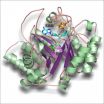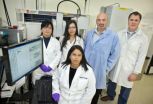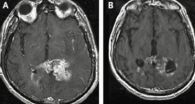(Press-News.org) This press release is available in German.
With few exceptions, all known proteins are built up from only twenty amino acids. 25 years ago scientists discovered a 21st amino acid, selenocysteine and ten years ago a 22nd, the pyrrolysine. However, how the cell produces the unusual building block remained a mystery. Now researchers at the Technische Universitaet Muenchen have elucidated the structure of an important enzyme in the production of pyrrolysine. The scientific journal Angewandte Chemie reports on their results in its "Early View" online section.
Proteins are key players in many vital processes in living organisms. They transport substances, catalyze chemical reactions, pump ions or recognize signaling molecules. The complexity and variety of proteins is tremendous, in the human body alone there are more than 100,000 different proteins at work. But almost all of them are made up of just twenty different amino acids. Only a few highly specialized proteins additionally contain selenocysteine, the very rare 21st amino acid discovered in 1986.
A big surprise was the discovery of a 22nd amino acid in methane-producing archaea of the family Methanosarcinaceae in 2002: pyrrolysine. It is genetically encoded in a similar manner as that of selenocysteine and the other twenty amino acids. The archaea use the unusual amino acid in proteins that they need for energy conversion. Pyrrolysine is located in the catalytic center of the proteins and is essential for their function. The energy generation process of the archaebacteria would not work without pyrrolysine.
In March 2011, scientists at Ohio State University succeeded in deciphering parts of the manufacturing process of pyrrolysine. They proposed a reaction mechanism suggesting that the enzyme PylB catalyzes the first step of pyrrolysine biosynthesis by converting the amino acid lysine to the intermediate product metyhlornithine. Scientists headed by Michael Groll, Professor of Biochemistry at the TUM-Department of Chemistry, could now elucidate the crystalline structure of PylB using X-ray structure analysis.
To their great surprise, they caught the enzyme literally "in the act": at the time of crystallization the reaction product, methylornithine, had not left the enzyme. It adhered to a confined space, a kind of "reaction vessel", still in connection with the centers of the enzyme responsible for its creation. "That the product was still present in the enzyme, was something special and a great stroke of luck," says Felix Quitterer, a member of the scientific staff at the Department of Biochemistry and lead author of the publication. "We were not only able to directly detect the methylornithine, but also retroactively reconstruct how it is created from the source amino acid lysine."
This reaction was not only hitherto unknown, it is also very difficult to catalyze. It is a cluster of four iron and four sulfur atoms in the active site of the enzyme that is the key to the conversion. "This is a really unusual enzymatic reaction. Up to now no chemist in the laboratory is able to synthesize methylornithine in a one-step reaction starting from lysine," says Michael Groll.
The conversion of lysine to methylornithine is helping scientists to understand how archaebacteria can modify an existing system to enable the formation of a tailored amino acid that, when installed in the appropriate protein, catalyzes a very specific reaction. Researchers can use this knowledge to create artificial amino acids for "custom tailored" enzymes with special properties that could, for example, find applications in industrial biotechnology and medicine.
There is, however, a more fundamental reason for the great interest in the synthesis of the 22nd amino acid: Scientists are hoping to find new clues to the evolutionary development of the amino acid canon. Why does the vast complexity of proteins in living organisms descend from only a few natural amino acids, even though the genetic code would be able to encode many more? An answer to this fundamental question on the minimum requirements for life has thus far eluded scientists. Selenocysteine and pyrrolysine are exotic exceptions. But knowledge about their development from the standard amino acids helps to come a little closer to the answer.
INFORMATION:
This research was funded by the Hans-Fischer-Gesellschaft and the King Abdullah University of Science and Technology, as well as the Cluster of Excellence Center for Integrated Protein Science Munich. The measurements were performed at the PXI beamline at the Paul Scherrer Institute (Villigen, Switzerland).
Original publication:
Crystal structure of methylornithine synthase (PylB): Insights into the pyrrolysine biosynthesis. Felix Quitterer, Anja List, Wolfgang Eisenreich, Adelbert Bacher and Michael Groll, Angewandte Chemie, Early View, 16. Nov. 2011 – DOI: 10.1002/ange.201106765 Link: http://onlinelibrary.wiley.com/doi/10.1002/anie.201106765/abstract
Enzymatic synthesis of pyrrolysine, the mysterious 22nd amino acid
On the path to tailored enzymes
2011-11-21
ELSE PRESS RELEASES FROM THIS DATE:
MU researchers develop tool that saves time, eliminates mistakes in diabetes care
2011-11-21
COLUMBIA, Mo. – In the fast-paced world of health care, doctors are often pressed for time during patient visits. Researchers at the University of Missouri developed a tool that allows doctors to view electronic information about patients' health conditions related to diabetes on a single computer screen. A new study shows that this tool, the diabetes dashboard, saves time, improves accuracy and enhances patient care.
The diabetes dashboard provides information about patients' vital signs, health conditions, current medications, and laboratory tests that may need to be ...
Colon cancer screening campaign erases racial, gender gaps in use of colonoscopy
2011-11-21
Since the 1970s, U.S. mortality rates due to colorectal cancer have declined overall, yet among blacks and Hispanics, the death rates rose. Evidence suggests that underuse of colonoscopy screening among these groups is one reason for the large disparities. In 2003, New York City launched a multifaceted campaign to improve colonoscopy rates among racial and ethnic minorities and women. A new study conducted by researchers at Columbia University's Mailman School of Public Health and the NYC Department of Health and Mental Hygiene demonstrates the notable success of the campaign. ...
A corny turn for biofuels from switchgrass
2011-11-21
Many experts believe that advanced biofuels made from cellulosic biomass are the most promising alternative to petroleum-based liquid fuels for a renewable, clean, green, domestic source of transportation energy. Nature, however, does not make it easy. Unlike the starch sugars in grains, the complex polysaccharides in the cellulose of plant cell walls are locked within a tough woody material called lignin. For advanced biofuels to be economically competitive, scientists must find inexpensive ways to release these polysaccharides from their bindings and reduce them to fermentable ...
Great Plains river basins threatened by pumping of aquifers
2011-11-21
CORVALLIS, Ore. – Suitable habitat for native fishes in many Great Plains streams has been significantly reduced by the pumping of groundwater from the High Plains aquifer – and scientists analyzing the water loss say ecological futures for these fishes are "bleak."
Results of their study have been published in the journal Ecohydrology.
Unlike alluvial aquifers, which can be replenished seasonally with rain and snow, these regional aquifers were filled by melting glaciers during the last Ice Age, the researchers say. When that water is gone, it won't come back – at ...
Old drugs find new target for treating brain tumor
2011-11-21
Scientists at the University of California, San Diego School of Medicine and UC San Diego Moores Cancer Center, in collaboration with colleagues in Boston and South Korea, say they have identified a novel gene mutation that causes at least one form of glioblastoma (GBM), the most common type of malignant brain tumor.
The findings are reported in the online edition of the journal Cancer Research.
Perhaps more importantly, the researchers found that two drugs already being used to treat other forms of cancer effectively prolonged the survival of mice modeling this particular ...
GOES satellite eyeing late season lows for tropical development
2011-11-21
Its late in the Atlantic and eastern Pacific hurricane seasons, but the calendar isn't stopping the tropics. The GOES-13 satellite is keeping forecasters informed about developing lows like System 90E in the eastern Pacific and another low pressure area in the Atlantic.
System 90E and the Atlantic low pressure area were both captured in one image from the NOAA's GOES-13 satellite today, November 18, 2011 at 1145 UTC (7:45 a.m. EST). The image was created by the NASA GOES Project (in partnership with NOAA) at NASA's Goddard Space Flight Center in Greenbelt, Maryland.
The ...
New NASA missions to investigate how Mars turned hostile
2011-11-21
Maybe because it appears as a speck of blood in the sky, the planet Mars was named after the Roman god of war. From the point of view of life as we know it, that's appropriate. The Martian surface is incredibly hostile for life. The Red Planet's thin atmosphere does little to shield the ground against radiation from the Sun and space. Harsh chemicals, like hydrogen peroxide, permeate the soil. Liquid water, a necessity for life, can't exist for very long here --any that does not quickly evaporate in the diffuse air will soon freeze out in subzero temperatures common over ...
Walking through doorways causes forgetting, new research shows
2011-11-21
We've all experienced it: The frustration of entering a room and forgetting what we were going to do. Or get. Or find.
New research from University of Notre Dame Psychology Professor Gabriel Radvansky suggests that passing through doorways is the cause of these memory lapses.
"Entering or exiting through a doorway serves as an 'event boundary' in the mind, which separates episodes of activity and files them away," Radvansky explains.
"Recalling the decision or activity that was made in a different room is difficult because it has been compartmentalized."
The study ...
NASA's TRMM satellite sees deadly tornadic thunderstorms in Southeastern US
2011-11-21
Tornadoes are expected to accompany severe storms in the springtime in the U.S., but this time of year they also usually happen. When a line of severe thunderstorms associated with a cold front swept through the U.S. southeast on Nov. 16, TRMM collected rainfall data on the dangerous storms from space.
NASA's Tropical Rainfall Measuring Mission (TRMM) satellite flew over the southeastern United States on November 16, 2011 at 2310 UTC (6:10 p.m. EST) when tornadoes were occurring with a line of thunderstorms that stretched from western Florida north through North Carolina. ...
A failing sense of smell can be reversed
2011-11-21
NEW YORK, November 20, 2011 – In a new study scientists at NYU Langone Medical Center have shown that the sense of smell can be improved. The new findings, published online November 20, 2011, in Nature Neuroscience, suggest possible ways to reverse the loss of smell due to aging or disease.
Smell is unique among our senses, explains Donald A. Wilson, PhD, professor of child and adolescent psychiatry at NYU Langone Medical Center and senior research scientist at the Emotional Brain Institute at Nathan S. Kline Institute for Psychiatric Research, who led the study. The ...
LAST 30 PRESS RELEASES:
Short, light-intensity exercise boosts executive function and elevates mood in children
Jeonbuk National University researchers reveal new interface engineering strategy for efficient and stable back-contact solar cells
Tyrosinase drives hydroquinone-induced exogenous ochronosis: not HGD inhibition
UMass Amherst chemists develop unique tool for studying RNA
Disappointment alters brain chemistry and behavior
A built-in odometer: new study reveals how the brain measures distance
Stress-related brain signals drive risk of cardiovascular disease in people with depression and anxiety
New details on role of fat transport molecules in Alzheimer’s onset
Study illuminates how an antiviral defense mechanism may lead to Alzheimer’s disease
Spot the males: New gene-editing method could transform mosquito control
AI learns to build simple equations for complex systems
NAU team releases 13 years of detailed U.S. CO2 emissions data
Unveiling how sodium-ion batteries can charge faster than lithium-ion ones
How do childcare tax credits affect children’s long-term health?
Can an electronic nose detect indoor mold?
Do natural disasters have long-term impacts on mortality in older adults?
Modification improves sodium‐ion batteries as an alternative to lithium-ion batteries
Parasports provide a range of benefits for people with cerebral palsy
How does grandparental care affect children’s health?
Why are there so many Nordic mediators?
Young shark species more vulnerable to extinction
Mobile fetal heart monitoring linked to fewer newborn deaths in Tanzania
Bluey’s dad offered professorial chair in archaeology at Griffith University
Beyond small data limitations: Transfer learning-enabled framework for predicting mechanical properties of aluminum matrix composites
Unveiling non-thermal catalytic origin of direct current-promoted catalysis for energy-efficient transformation of greenhouse gases to valuable chemicals
Chronic breathlessness emerging as a hidden strain on hospitals
Paleontologists find first fossil bee nests made inside fossil bones
These fossils were the perfect home for ancient baby bees
Not everyone reads the room the same. A new study examines why.
New research identifies linked energy, immune and vascular changes in ME/CFS
[Press-News.org] Enzymatic synthesis of pyrrolysine, the mysterious 22nd amino acidOn the path to tailored enzymes






